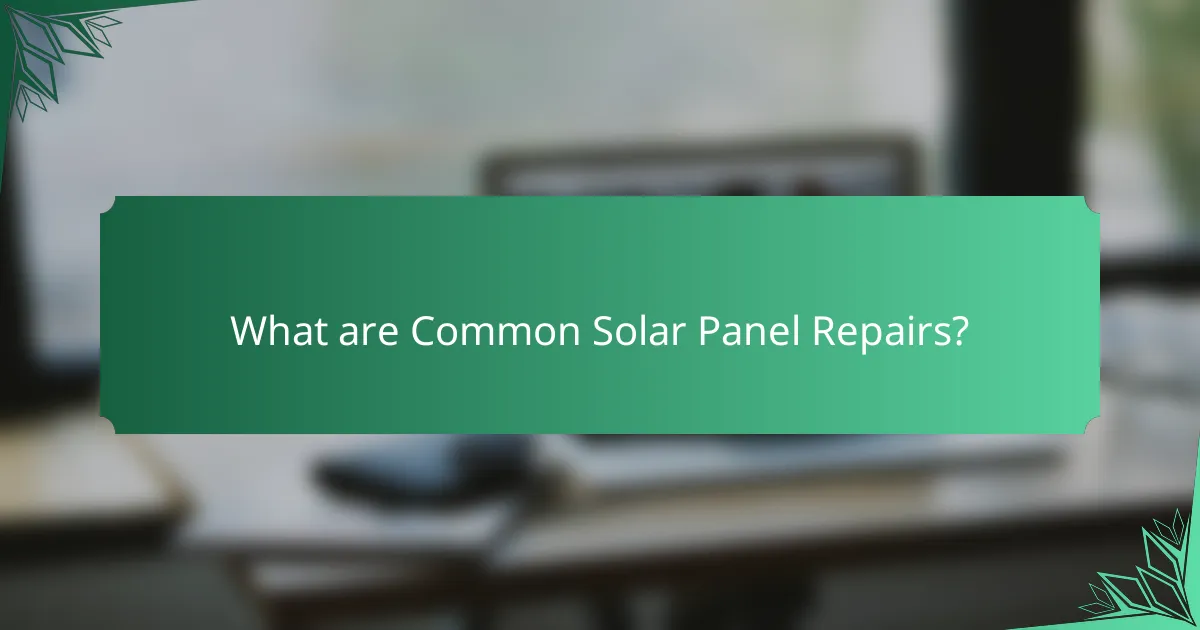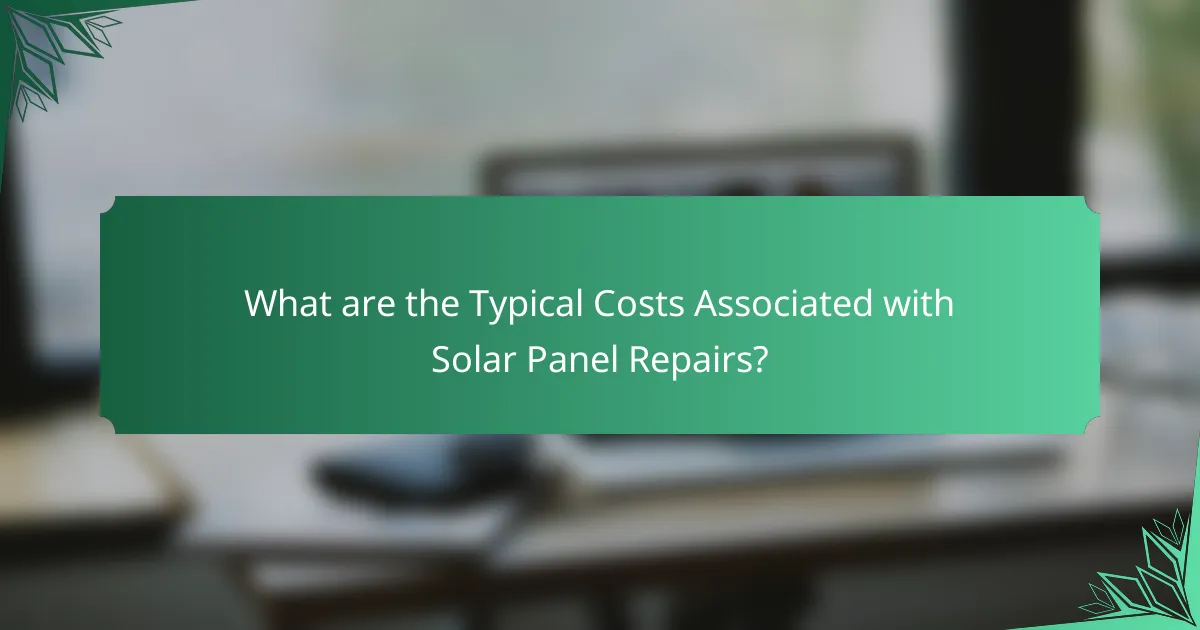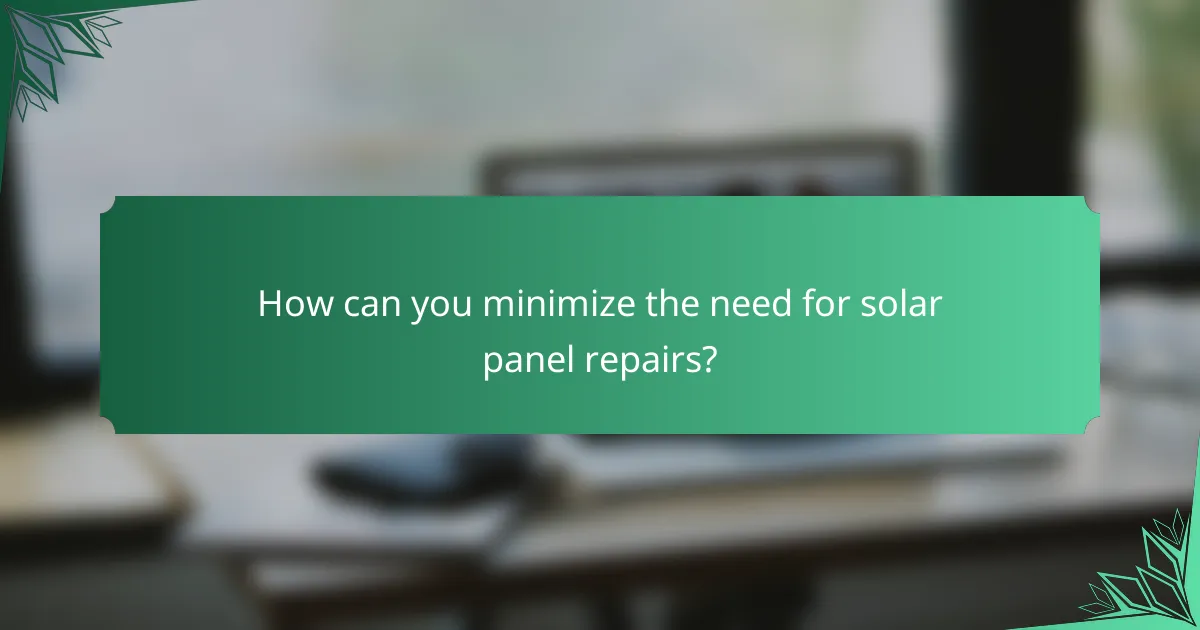
What are Common Solar Panel Repairs?
Common solar panel repairs include fixing damaged panels, replacing inverters, and repairing wiring issues. Damaged panels can result from hail, debris, or improper installation. Inverters convert solar energy into usable electricity and may need replacement if they malfunction. Wiring issues can arise from wear and tear or animal interference. Regular maintenance can help identify these problems early. According to the National Renewable Energy Laboratory, timely repairs can extend the lifespan of solar systems.
What types of issues commonly affect solar panels?
Common issues that affect solar panels include physical damage, dirt and debris accumulation, and electrical failures. Physical damage can occur from weather events like hail or strong winds. Dirt and debris can reduce efficiency by blocking sunlight. Electrical failures may arise from faulty wiring or inverter issues. These problems can lead to decreased energy production. Regular maintenance helps identify and resolve these issues early.
How do physical damages impact solar panel performance?
Physical damages significantly reduce solar panel performance. Cracks in the panel can lead to energy losses of up to 30%. Damaged connections may cause intermittent power generation. Water infiltration from physical breaches can result in corrosion and further deterioration. These issues can decrease overall efficiency and lifespan. Studies show that even minor damages can lead to substantial drops in energy output. Regular inspections can help identify and mitigate these impacts early.
What electrical issues can arise in solar panel systems?
Electrical issues in solar panel systems can include inverter failures, wiring problems, and grounding faults. Inverter failures occur when the device converting DC to AC power malfunctions. This can lead to system shutdowns and energy loss. Wiring problems may arise from loose connections or damaged cables, causing inefficiencies or safety hazards. Grounding faults can result in electrical shocks or fire risks if the system is not properly grounded. Regular maintenance and inspections can help identify these issues early. According to the National Renewable Energy Laboratory, approximately 80% of solar system failures are related to electrical issues.
Why is it important to address solar panel repairs promptly?
Addressing solar panel repairs promptly is crucial to maintain efficiency. Delays in repairs can lead to decreased energy production. This reduction can result in financial losses due to lower electricity generation. Additionally, unresolved issues may worsen over time, leading to more extensive damage. For example, a small crack can eventually compromise the entire panel. Timely repairs can help avoid costly replacements. Regular maintenance also ensures the system operates at peak performance. Studies show that well-maintained solar panels can produce up to 25% more energy over their lifetime.
How can delayed repairs affect energy efficiency?
Delayed repairs can significantly reduce energy efficiency in solar panel systems. When components such as inverters or panels are damaged, their performance declines. This leads to lower energy output and increased energy costs. For example, a malfunctioning inverter can cause a drop in energy conversion efficiency by up to 20%. Additionally, neglecting to fix minor issues can lead to more severe damage over time. Research indicates that timely maintenance can improve system efficiency by 10-30%. Therefore, addressing repairs promptly is crucial for maintaining optimal energy efficiency in solar installations.
What are the potential safety risks associated with unaddressed repairs?
Unaddressed repairs can lead to significant safety risks in solar panel systems. These risks include electrical hazards, such as short circuits or fires caused by damaged wiring. Additionally, structural issues can arise from loose or damaged mounting systems, posing a risk of panels falling. Water intrusion from unsealed components can lead to corrosion and electrical failure. Furthermore, unaddressed repairs may void warranties, leaving homeowners financially vulnerable. Regular maintenance is crucial to mitigate these risks and ensure safe operation.

What are the Typical Costs Associated with Solar Panel Repairs?
Typical costs associated with solar panel repairs range from $150 to $1,000. Minor repairs, such as fixing wiring issues, typically cost around $150 to $300. More extensive repairs, like replacing a damaged panel, can cost between $300 and $800. In cases where the inverter needs replacement, costs may reach $1,000 or more. Factors influencing these costs include the type of repair, the extent of damage, and labor rates in the area. According to HomeAdvisor, the national average for solar panel repair is approximately $650.
How do repair costs vary by type of issue?
Repair costs for solar panels vary significantly based on the type of issue. Minor issues, such as loose connections, can cost around $100 to $300 to fix. Moderate problems, like replacing a damaged inverter, typically range from $1,000 to $3,000. Major repairs, such as replacing the entire solar panel array, can exceed $10,000. The complexity of the repair affects labor costs, which can vary by region. For example, labor rates in urban areas may be higher than in rural locations. Additionally, warranty coverage can influence out-of-pocket expenses for repairs. According to the National Renewable Energy Laboratory, average repair costs can fluctuate based on the specific components involved and the extent of the damage.
What is the average cost for repairing physical damages?
The average cost for repairing physical damages to solar panels ranges from $200 to $1,500. This cost varies based on the extent of the damage and the specific repairs needed. Minor damages, such as small cracks or surface scratches, typically fall on the lower end of this range. More significant issues, like broken panels or extensive frame damage, can lead to costs at the higher end. According to industry estimates, replacing a single broken solar panel may cost approximately $300 to $500. Additionally, labor costs for repairs can add another $100 to $500 depending on the technician’s rates and time required.
How much should you expect to pay for electrical repairs?
Electrical repairs typically range from $100 to $500. The cost depends on the complexity of the issue and local labor rates. Simple repairs, like replacing a switch, may cost around $100. More complex issues, such as rewiring, can exceed $500. According to HomeAdvisor, the average cost for electrical repairs is about $300. Factors influencing the price include the type of repair and the electrician’s experience.
What factors influence the cost of solar panel repairs?
The cost of solar panel repairs is influenced by several factors. Labor costs are a significant component, varying by region and technician expertise. The extent of damage impacts repair costs; minor issues are less expensive to fix than major ones. The type of solar panels also matters; some models are more complex and costly to repair. Availability of replacement parts can affect pricing; rare parts may lead to higher costs. Warranty coverage influences expenses; repairs under warranty typically incur no cost. The age of the system can impact repair decisions; older systems may require more frequent repairs. Lastly, the urgency of the repair request can lead to increased costs for expedited service.
How do the age and brand of solar panels affect repair costs?
The age and brand of solar panels significantly affect repair costs. Older panels may require more frequent repairs due to wear and tear. This can lead to higher cumulative costs over time. Additionally, certain brands have better warranties and support services, which can lower repair expenses. For example, high-quality brands often provide longer warranties, reducing out-of-pocket costs for repairs. In contrast, lesser-known brands may lack comprehensive support, leading to higher costs when repairs are needed. According to a study by the National Renewable Energy Laboratory, repair costs can vary by up to 30% based on brand reputation and warranty coverage.
What role does the location of the installation play in repair pricing?
The location of the installation significantly impacts repair pricing for solar panels. Geographic factors influence labor costs, transportation expenses, and local regulations. Urban areas typically have higher labor rates due to demand and cost of living. In contrast, rural locations may incur additional travel fees for technicians. Local regulations can also dictate specific repair standards, affecting overall costs. For instance, areas with stringent building codes may require specialized materials or permits, increasing expenses. Additionally, weather conditions in certain regions can lead to more frequent repairs, further influencing pricing. Overall, the installation location plays a crucial role in determining the total cost of solar panel repairs.

How can you minimize the need for solar panel repairs?
Regular maintenance minimizes the need for solar panel repairs. Schedule professional inspections at least once a year. Clean the panels regularly to remove dirt and debris. Ensure that the installation is done correctly to avoid future issues. Monitor the system’s performance consistently for any irregularities. Use high-quality components to enhance durability. Protect the panels from potential hazards, such as falling branches or heavy snow. These practices can significantly reduce repair frequency and associated costs.
What preventive maintenance practices should be followed?
Preventive maintenance practices for solar panels include regular inspections, cleaning, and monitoring system performance. Inspections should occur at least twice a year to identify any damage or wear. Cleaning the panels removes dirt and debris that can reduce efficiency. Monitoring system performance involves checking energy output regularly to ensure optimal function. Additionally, checking electrical connections and ensuring proper grounding is essential. These practices help extend the lifespan of the solar panel system and maintain efficiency. Regular maintenance can prevent costly repairs and ensure the system operates at maximum capacity.
How often should solar panels be inspected for issues?
Solar panels should be inspected at least once a year for issues. Regular inspections help identify potential problems early. They can include checking for dirt, debris, and any physical damage. Additionally, monitoring performance metrics can reveal inefficiencies. Some manufacturers recommend biannual checks for optimal maintenance. Regular inspection can prolong the lifespan of solar panels. According to the U.S. Department of Energy, routine maintenance is essential for maximizing energy output.
What cleaning methods help maintain solar panel efficiency?
Regular cleaning methods help maintain solar panel efficiency. Cleaning panels removes dirt, dust, and debris that block sunlight. This can significantly improve energy output. Use water and a soft brush for effective cleaning. Avoid harsh chemicals that may damage the surface. Rinsing with a hose is often sufficient for light dirt. For heavy buildup, a gentle scrub may be necessary. Cleaning should be done during cooler times of the day to prevent streaks. Studies show that clean panels can operate at up to 20% higher efficiency.
What are some common troubleshooting tips for solar panel owners?
Check for shading on solar panels. Shading can significantly reduce energy production. Remove any obstructions like branches or debris.
Inspect the wiring for damage. Damaged wires can cause performance issues. Look for frayed or exposed wires.
Monitor the inverter status. An inverter that shows an error code may need resetting or servicing. Regularly check the inverter’s display for alerts.
Clean the panels regularly. Dust and dirt can accumulate and block sunlight. Use a soft cloth or a gentle water spray for cleaning.
Verify the system’s performance. Compare current energy output with historical data. A significant drop in output may indicate a problem.
Check the mounting system. Ensure that panels are securely mounted and not loose. Loose panels can lead to damage or misalignment.
Look for physical damage. Inspect panels for cracks or chips. Physical damage can affect performance and may require repair or replacement.
How can you identify minor issues before they escalate?
Regular maintenance and monitoring can help identify minor issues before they escalate. Inspect solar panels for dirt, debris, and physical damage. Check for shading from nearby trees or structures that can reduce efficiency. Monitor energy output regularly to detect drops in performance. Use a multimeter to test voltage and current levels. Look for signs of wear on wiring and connectors. Schedule professional inspections annually for thorough assessments. Studies show that proactive maintenance can extend the lifespan of solar systems and enhance performance.
What steps should you take when experiencing a drop in solar energy output?
Check the solar panels for dirt or debris. Cleaning the panels can restore energy output. Inspect for shading from nearby trees or structures. Trim any obstructing foliage to improve sunlight exposure. Examine the inverter for error messages or faults. Resetting or replacing the inverter may be necessary. Review the solar energy production data. Compare recent output to historical performance to identify issues. Consult a professional if the problem persists. Technicians can diagnose and fix underlying issues effectively.
The main entity of this article is common solar panel repairs, which encompass issues such as damaged panels, inverter replacements, and wiring problems. The article outlines the types of issues affecting solar panels, including physical damage and electrical failures, and emphasizes the importance of timely repairs to maintain efficiency and safety. It details typical repair costs, factors influencing these costs, and preventive maintenance practices to minimize repair needs. Additionally, the article provides troubleshooting tips for solar panel owners to identify and address minor issues before they escalate.